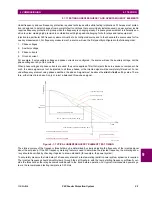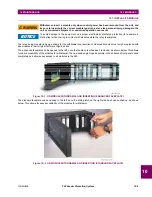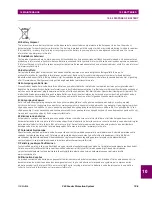
8-2
F60 Feeder Protection System
GE Multilin
8.1 HIGH-IMPEDANCE (HI-Z) FAULT DETECTION
8 THEORY OF OPERATION
8
8.1.3 RANDOMNESS ALGORITHM
The Randomness algorithm monitors the same set of component energies as the Energy algorithm. However, rather than
checking for a sudden, sustained increase in the value of the monitored component energy, it looks for a sudden increase
in a component followed by highly erratic behavior. This type of highly erratic behavior is indicative of many arcing faults.
Just as with the Energy algorithm, if the Randomness algorithm detects a suspicious event in one of its monitored compo-
nents, it reports it to the Expert Arc Detector algorithm, resets itself, and continues to monitor for another suspicious event.
8.1.4 EXPERT ARC DETECTOR ALGORITHM
The purpose of the Expert Arc Detector Algorithm is to assimilate the outputs of the basic arc detection algorithms into one
"arcing confidence" level per phase. Note that there are actually 24 independent basic arc detection algorithms, since both
the Energy Algorithm and the Randomness Algorithm are run for the even harmonics, odd harmonics, and non-harmonics
for each phase current and for the neutral. The assimilation performed by the Expert Arc Detector Algorithm, then, is
accomplished by counting the number of arcing indications determined by any one of the twenty-four algorithms over a
short period of time (e.g. the last 30 seconds). Also taken into account is the number of different basic algorithms that indi-
cate arcing.
In the Expert Arc Detector Algorithm, the arcing confidence level for each phase increases as the number of basic algo-
rithms that indicate arcing (per phase) increases. It also increases with increasing numbers of indications from any one
basic algorithm. These increases in confidence levels occur because multiple, consecutive indications from a given algo-
rithm and indications from multiple independent algorithms are more indicative of the presence of arcing than a single algo-
rithm giving a single indication.
8.1.5 SPECTRAL ANALYSIS ALGORITHM
The Spectral Analysis algorithm is the third and final confirmation algorithm performed only when a high impedance condi-
tion is suspected.
The Spectral Analysis algorithm receives five seconds of averaged non-harmonic residual current spectrum data and com-
pares it to an ideal 1 /
f
curve. Depending on the result, three percent can be added to the arcing confidence level gener-
ated by the Expert Arc Detector Algorithm.
8.1.6 LOAD EVENT DETECTOR ALGORITHM
The Load Event Detector Algorithm examines, on a per-phase basis, one reading of RMS values per two-cycle interval for
each phase current and the neutral. It then sets flags for each phase current and for the neutral based on the following
events:
•
an overcurrent condition
•
a precipitous loss of load
•
a high rate-of-change
•
a significant three-phase event
•
a breaker open condition.
These flags are examined by the Load Analysis Algorithm. Their states contribute to that algorithm's differentiation between
arcing downed conductors and arcing intact conductors, and inhibit the Expert Arc Detector Algorithm from indicating the
need for an arcing alarm for a limited time following an overcurrent or breaker open condition.
Any of the above five flags will zero the Expert Arc Detector buffer, since the power system is in a state of change and the
values being calculated for use by the Energy and Randomness algorithms are probably not valid.
An extremely high rate of change is not characteristic of most high impedance faults and is more indicative of a breaker
closing, causing associated inrush. Since this type of inrush current causes substantial variations in the harmonics used by
the high impedance algorithms, these algorithms ignore all data for several seconds following a high rate-of-change event
that exceeds the associated rate-of-change threshold, in order to give the power system a chance to stabilize.
Содержание F60
Страница 10: ...x F60 Feeder Protection System GE Multilin TABLE OF CONTENTS ...
Страница 30: ...1 20 F60 Feeder Protection System GE Multilin 1 5 USING THE RELAY 1 GETTING STARTED 1 ...
Страница 138: ...4 28 F60 Feeder Protection System GE Multilin 4 2 FACEPLATE INTERFACE 4 HUMAN INTERFACES 4 ...
Страница 454: ...5 316 F60 Feeder Protection System GE Multilin 5 10 TESTING 5 SETTINGS 5 ...
Страница 500: ...7 14 F60 Feeder Protection System GE Multilin 7 1 COMMANDS 7 COMMANDS AND TARGETS 7 ...
Страница 508: ...8 8 F60 Feeder Protection System GE Multilin 8 2 FAULT LOCATOR 8 THEORY OF OPERATION 8 ...
Страница 522: ...10 12 F60 Feeder Protection System GE Multilin 10 6 DISPOSAL 10 MAINTENANCE 10 ...
Страница 660: ...B 116 F60 Feeder Protection System GE Multilin B 4 MEMORY MAPPING APPENDIX B B ...
Страница 706: ...E 10 F60 Feeder Protection System GE Multilin E 1 IEC 60870 5 104 APPENDIX E E ...
Страница 718: ...F 12 F60 Feeder Protection System GE Multilin F 2 DNP POINT LISTS APPENDIX F F ...
Страница 728: ...H 8 F60 Feeder Protection System GE Multilin H 2 ABBREVIATIONS APPENDIX H H Z Impedance Zone ...
Страница 730: ...H 10 F60 Feeder Protection System GE Multilin H 3 WARRANTY APPENDIX H H ...
















































